
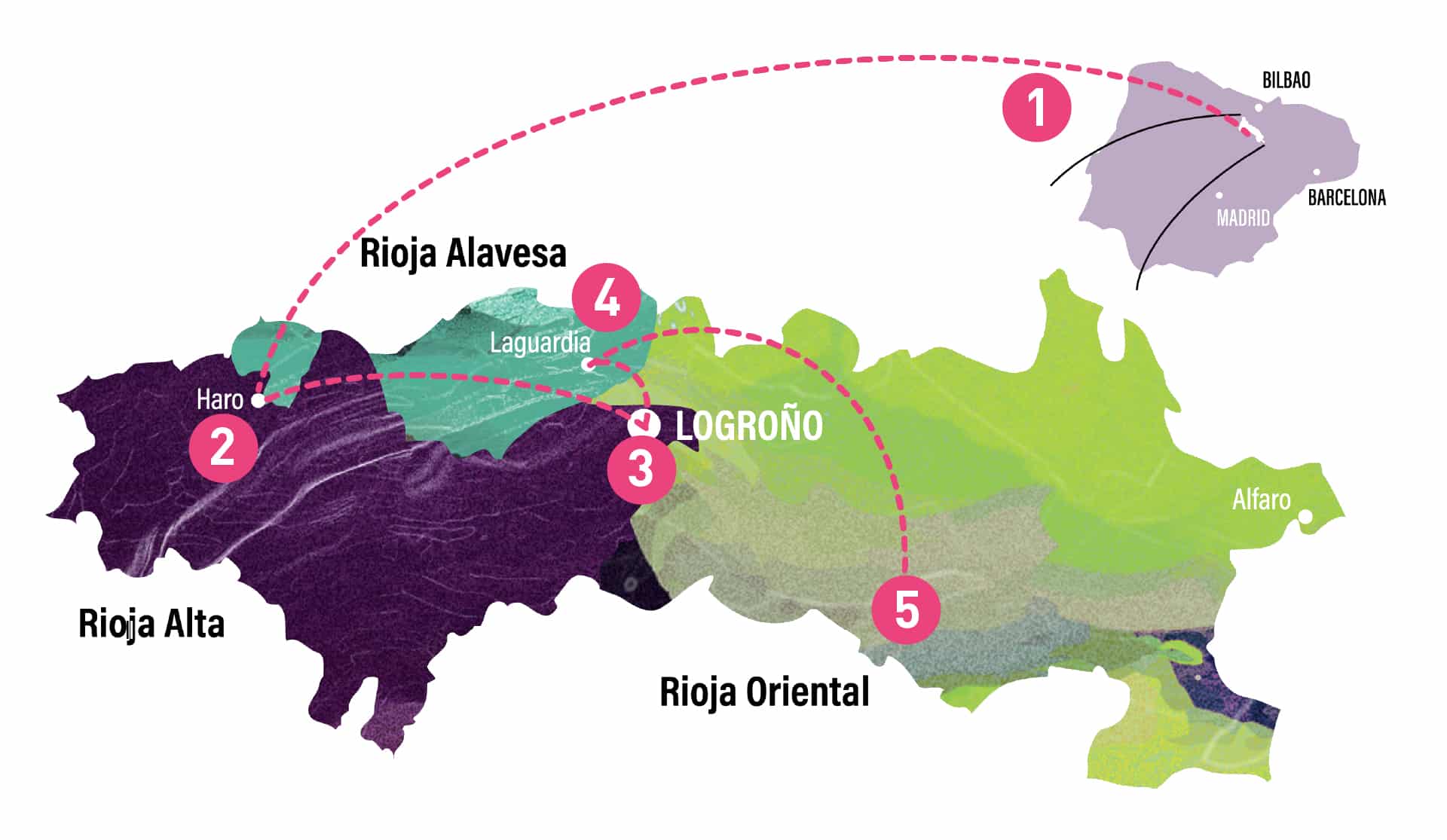

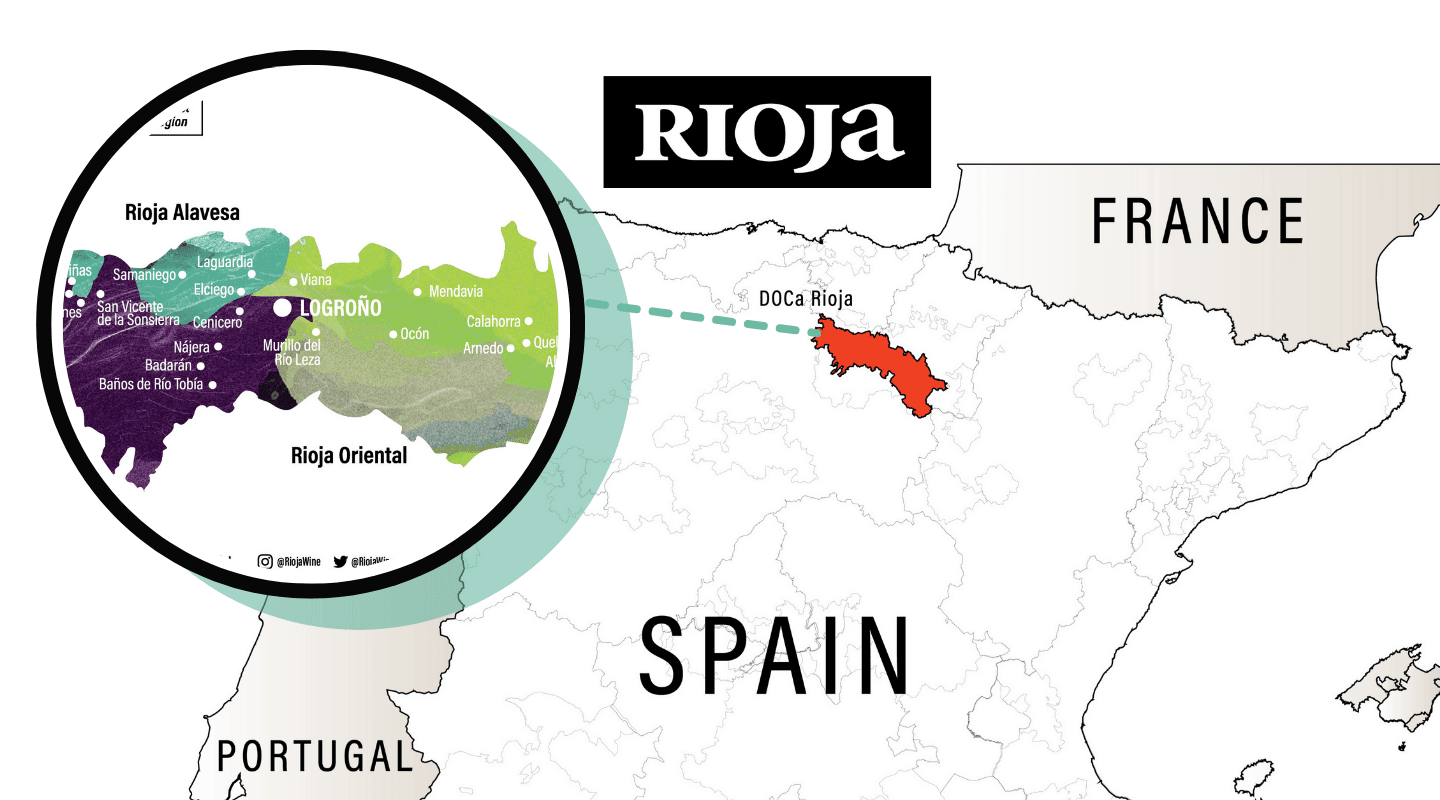
There are many reasons to visit Rioja…most notably its famous red wine and jaw-dropping landscape. But Spain’s premiere global wine region offers visitors far more than vineyard tours and tastings.
You can enjoy quiet reflection in one of the area’s historic monasteries, or trace a famous pilgrimage route. For a very different pilgrimage, you could participate in a tapas crawl – dubbed the “Trail of the Elephant” – or hike to a nearby hot spring. You could even throw wine on strangers (more on that later).
Nestled between two mountain ranges and bisected by the Ebro River, Spain’s first Denominacion de Origen (DO) offers a diverse landscape of lush forests below jagged mountains, verdant green vines rising through cracked red soil, and quiet stone churches between lively bodegas.
The region is steeped in history – boasting several Unesco World Heritage sites – lending a prevailing patience and pride of place. Rioja’s wines are known for their unique aging system, which prohibits their sale until they have reached their prime.
Rioja is located in Northeast Spain, along both banks of the Ebro River. It’s divided into three sub-regions: Rioja Alta, Rioja Alavesa and Rioja Oriental (formerly named Baja).
The easiest way to get there is to fly into Bilbao and drive one hour south to Haro or Logroño (most people connect through Madrid). Before we dive into wine country, let’s get oriented…
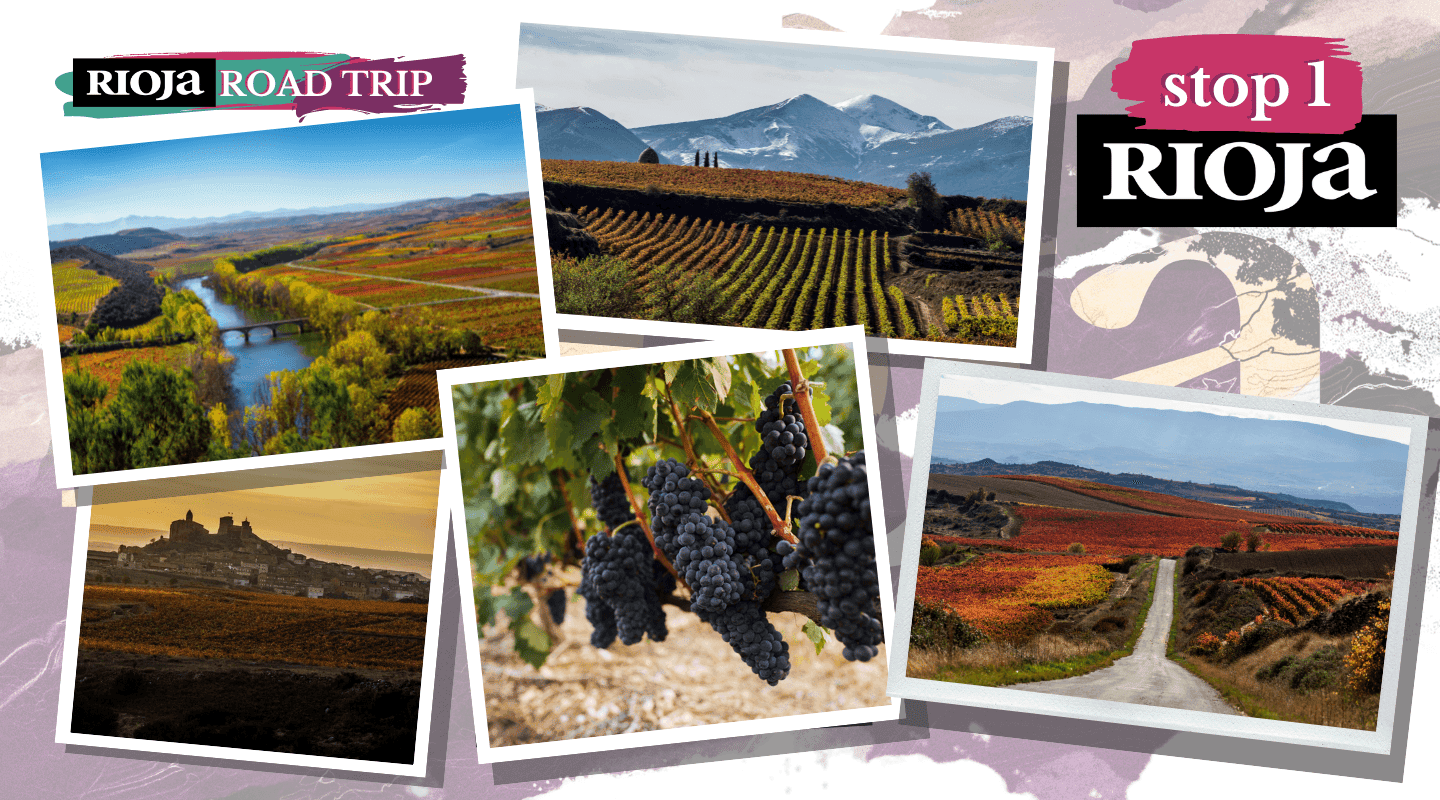
- Global wine region for centuries, dating back to the 11th century BC
- Spain’s first DO (Denominación de Origen) in 1925 and first DOCa (Calificada – of quality) in 1991
- Only wine region in the world that releases wines when they are ready to drink, thanks to a unique aging system.
- Most famous producer of Spain’s “Noble Grape”, Tempranillo
- Known worldwide for exceptional and affordable wines
Rioja’s vineyards were first cultivated by the Phoenicians in the 11th century BC, followed by the Celtibarians (Celts), and then the Romans. The wine region made the map during the Middle Ages thanks to the Camino de Santiago de Compostela – a pilgrimage route that goes right through Rioja.
A unique relationship between Rioja and Bordeaux started in the mid-1700s, when Rioja nobles went to Bordeaux to learn about their winemaking. Rioja officially adopted this method of making wines in the mid-to-late 1800s, which includes oak aging. Riojans call this point in their industry the ‘modern era’.
When Phylloxera decimated French vineyards in the late 1860’s, French winemakers came to Rioja to source wines to drink. Several families stayed, helping cement the relationship.
Despite being only 100 miles long and 30 miles wide, Rioja has two distinct climate systems. To the west, the land opens to the cooling Atlantic breezes. Following the Rio Ebro to the southeast, the vineyards benefit from the warm Mediterranean winds. Soils in Rioja are of three main types – ferrous clay, calcareous and alluvial.
Rioja’s reputation was built on its wine style of extended aging in American oak barrels, called the ‘Crianza’ system. (Crianza means nursery in Rioja, a nod to how they “educate” or “raise” the wines.) The rules include how much time wines must spend in 225-liter barrels and then in the bottle before release. The hallmark of Rioja wines is that they are not released until ready to drink under this system. There are region-wide practices that prevent a rush to sell, yet many bodegas take it a step further, keeping their Reserva and Gran Reserva wines well beyond the requirements to ensure they are aged to perfection before leaving the winery.
Rioja's Labeling System
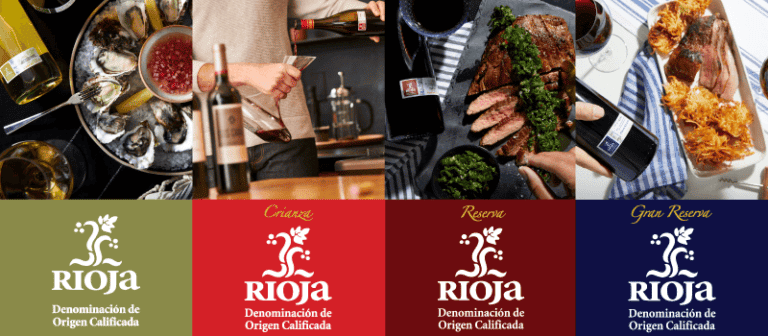

- There are currently 1.3 million barrels of wine aging in Rioja’s wine cellars!
- Most oak barrels are made of American oak, a practice begun in the 1800s and 1900s when Spain had holdings in the New World.
- Rioja was made famous in the Middle Ages thanks to a religious pilgrimage route that goes right through its vineyards.
- Rioja was Spain’s first DO (Denominación de Origen) in 1925 and first DOCa (Calificada – of quality) in 1991.
- Rioja’s famous aging system is called the Crianza system, which means nursery in Rioja – a nod to “raising” their wines.
- Rioja is now producing sparkling wines, called Espumosos de Rioja

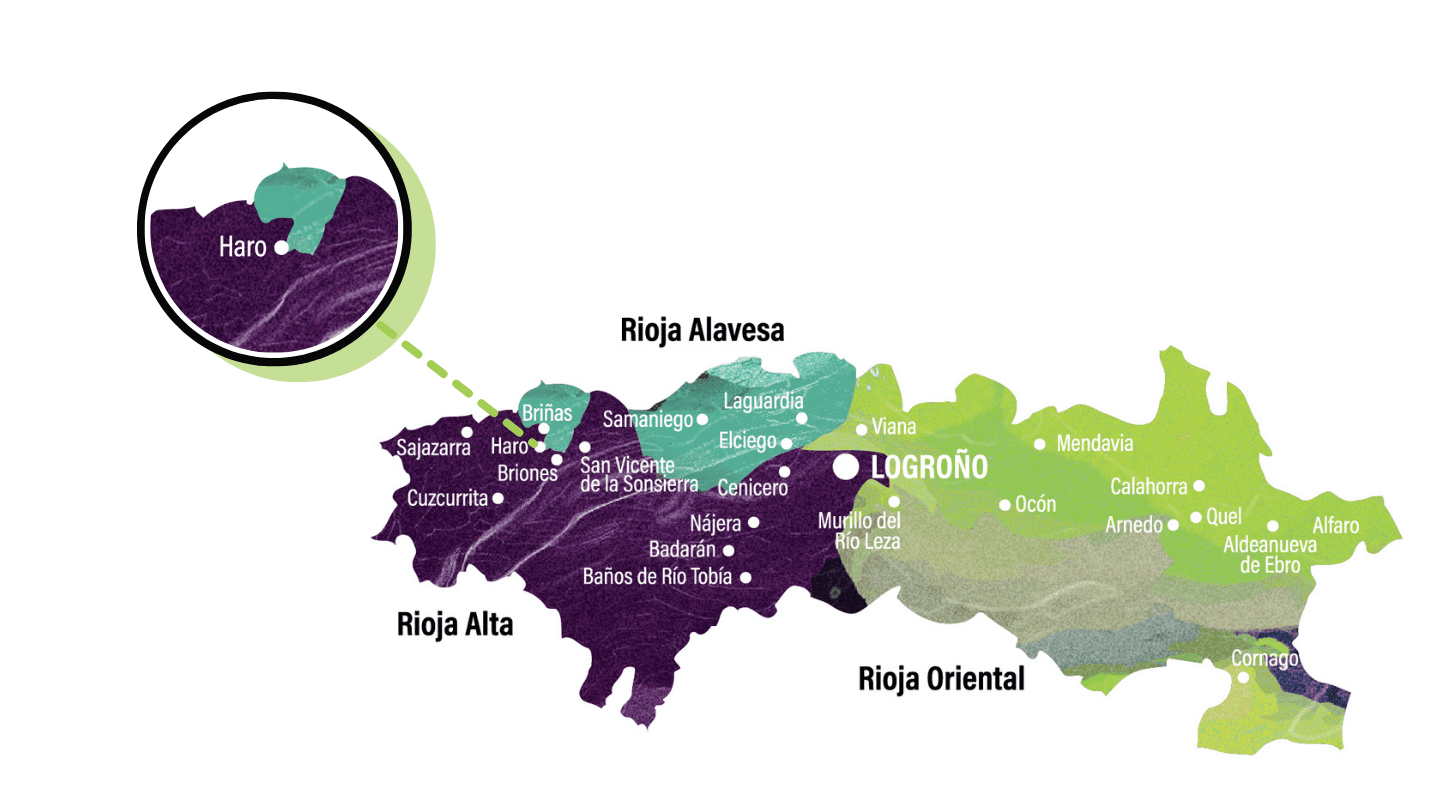
We begin our journey in the wine capital of Rioja. Situated in the Oja Valley of the Rioja Alta sub-region, the Ebro meanders through Haro with vineyards hugging both banks.
If there was one key word to this region, it would be age.
Haro is home to the highest concentration of centenary bodegas (wineries in operation for 100+ years) and numerous prized vineyards that supply grapes destined for benchmark Reserva and Gran Reserva wines.
Classic Rioja has been made here since the mid-1800s, a varietal blend enhanced through long aging in American Oak barrels.
Haro’s ideal location along the Ebro helped establish Rioja as a commercial success, providing a major way to export their wine to the rest of the world. The railroad, which came to Rioja in the 1860s, helped further those efforts and allowed RIoja to reach international markets.
Many centenary bodegas formed at this time, and the railroad played a critical role in sharing Rioja with the world. Today the Haro Station District, the Barrio de l’Estación, boasts the world’s largest concentration of historic wineries. It is recommended to visit the bodegas in the Barrio – as they represent some of Riojas finest.
All of Haro is walkable; beyond the Station District are many tasting rooms of the centenary bodegas, all within easy walking distance.
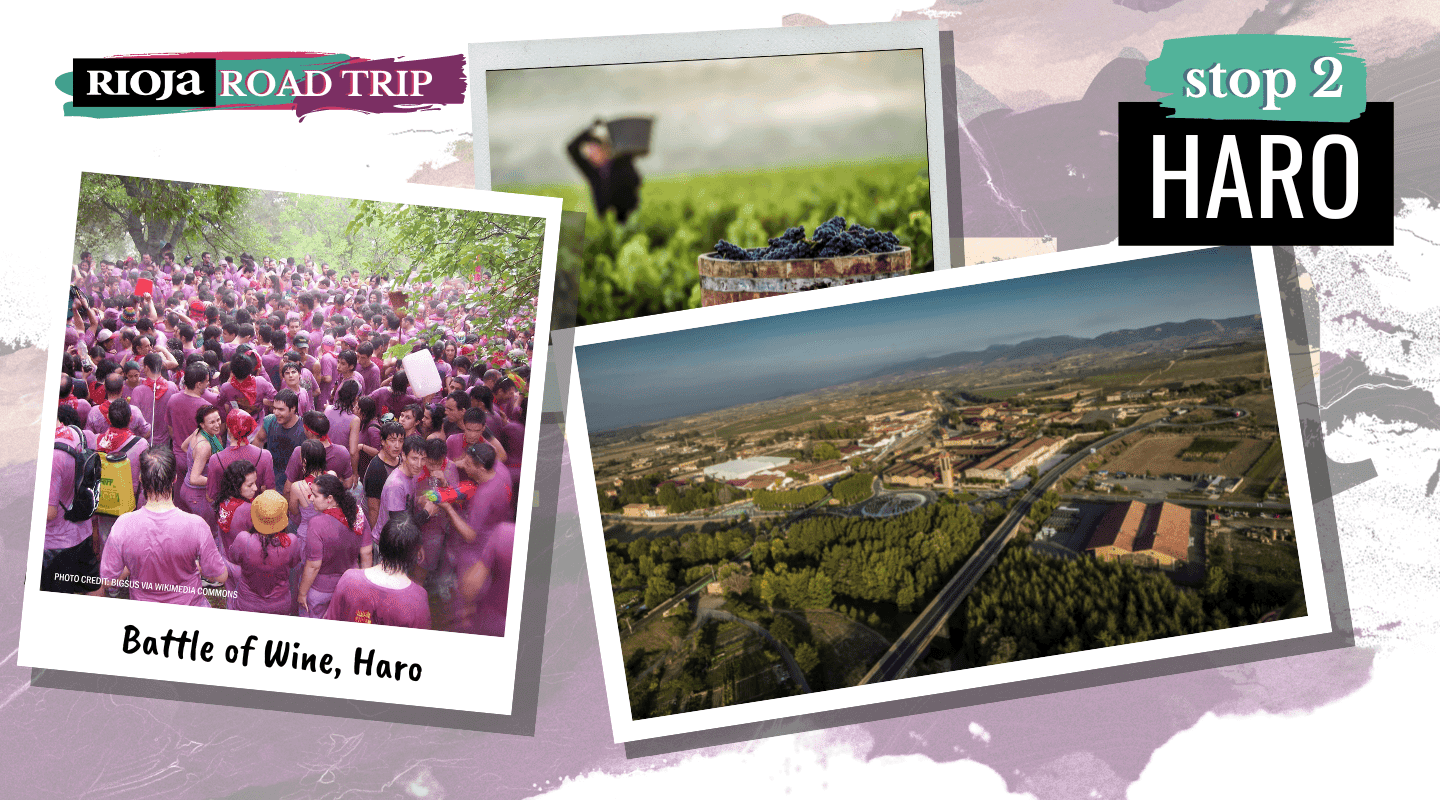

- In 1890, Haro became the first city in Spain to install electric street lights.
- Every year in June, Haro hosts the Haro Wine Battle Festival – where people throw thousands of liters of wine on each other!
- Many centenary bodegas still have their own cooperages in order to make their own wine barrels.

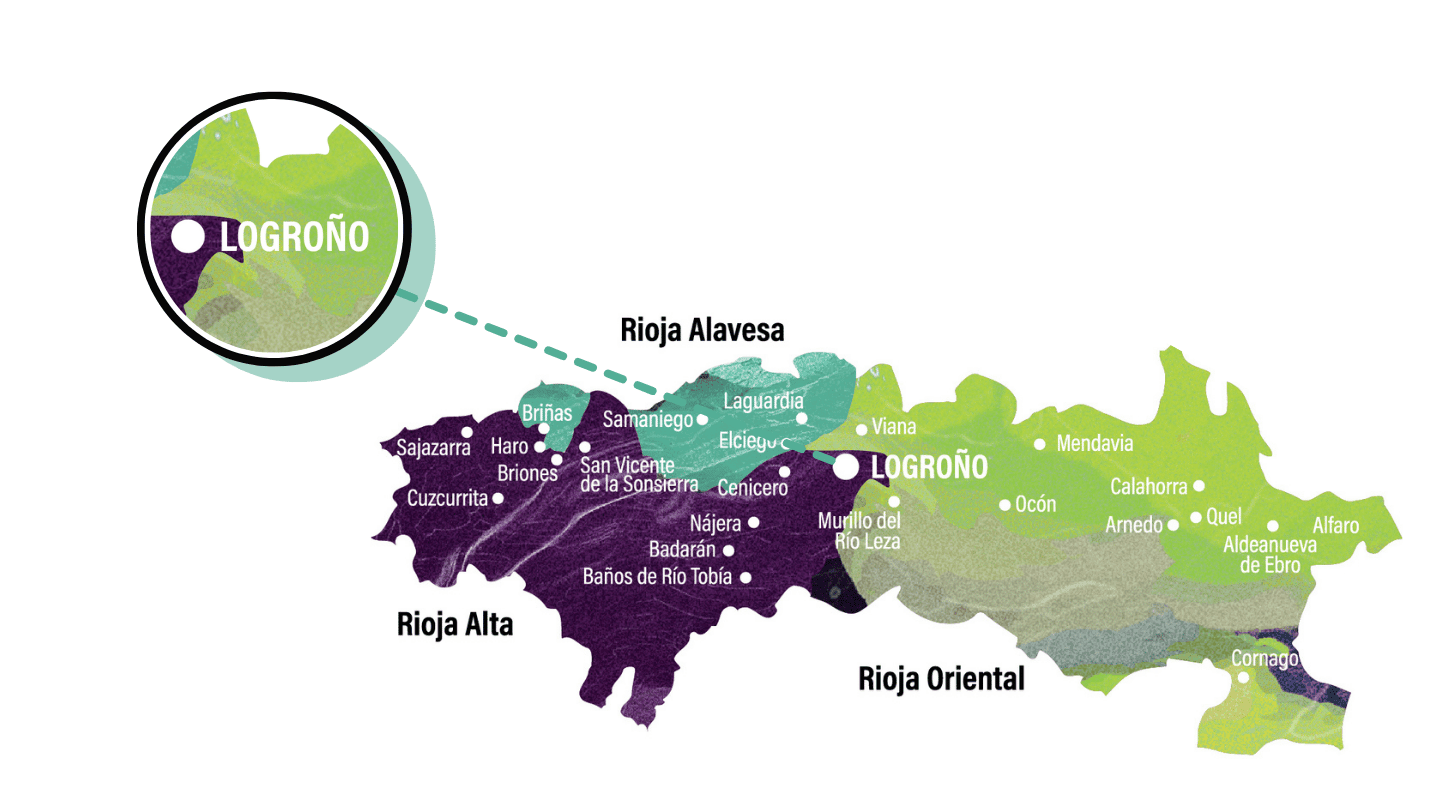
Rioja Alta was the first area planted in the region millennia ago. It’s not only the birthplace of Tempranillo (Spain’s Noble Grape) but also the origins of the Spanish language. Today this key sub-region has more vineyards than anywhere else in Rioja.
Its name translates to ‘High Rioja’ due to its location along the Ebro basin depression. Alta enjoys an Atlantic climate influence from the Bay of Biscay. Growing centers are located near the tributaries of the Ebro, notably the Oja, Tiron and Najerilla river valleys. The Najerilla is home to the most vineyards in Rioja.
In addition to many famous vineyards, Rioja Alta features gorgeous landscapes and unique gastronomy. The nearby city of Logroño is considered the Culinary Capital of Rioja. If you have time, visit the Calle Laurel district in Old Town for a tapas crawl.
Pick one of the many tapa bars lining its maze of cobblestone streets, order a glass of wine and a house signature tapa (normally on waxed paper or speared with a long toothpick). Once done head to the next place. Just be warned: locals call this the “Trail of the Elephant” because that is what you will feel like after one of these evenings!
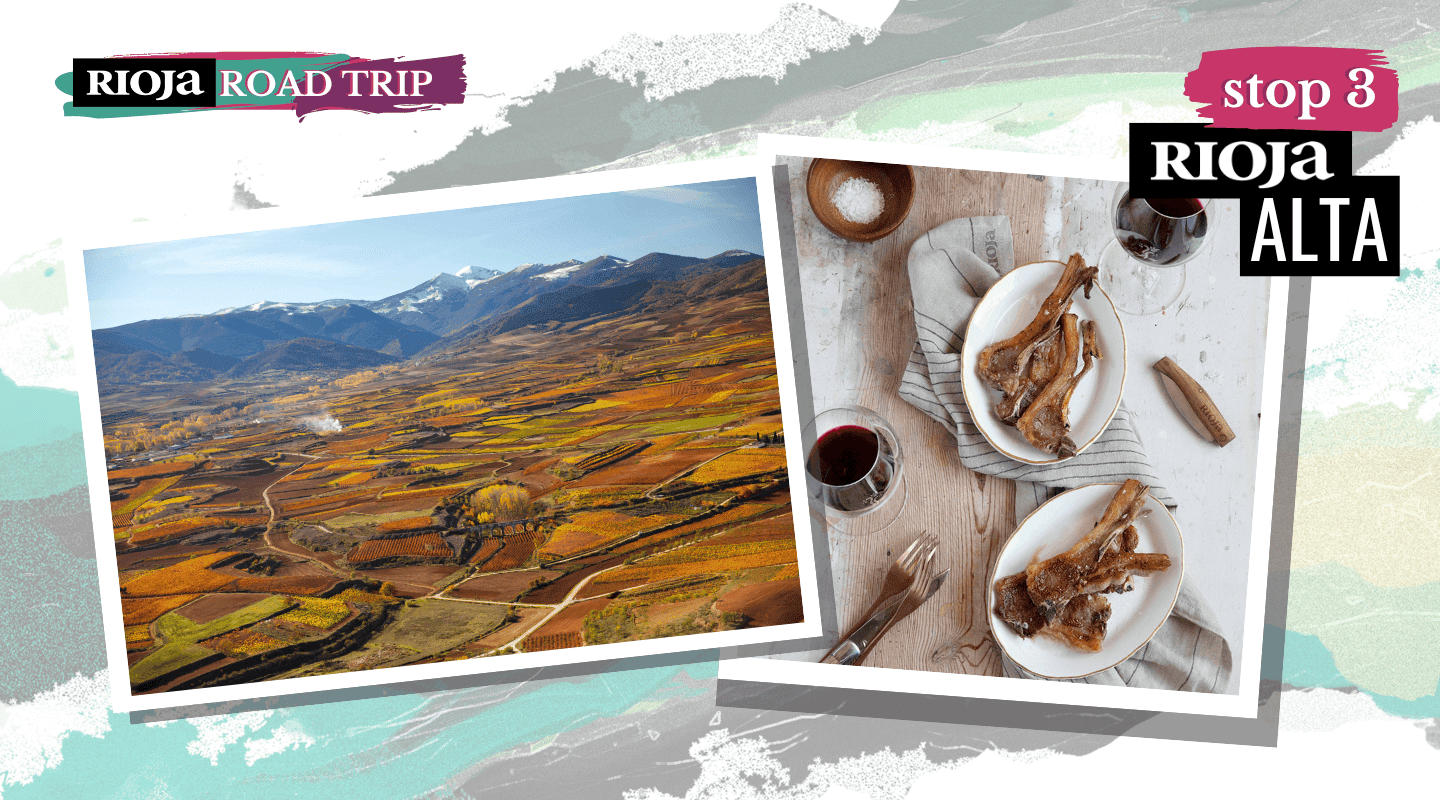
Tempranillo, garnacha, mazuelo, graciano. Viura and other white wines.
You’ll find all approved grape varieties in Rioja Alta, including old vine garnacha. Wines of this sub-region are known for their complex aromas when they age and are generally light to medium bodied. If the wines are made of grapes from the colder areas of Rioja Alta, acids will be high. In the Najerilla Valley, the wines will show as ‘sanguine’ or bloodlike, due to the ferrous clay soils.

- Rioja Alta is the birthplace of both the Spanish language and of Tempranillo.
- 42% of Rioja vineyards are located in this sub-region, mainly on the right bank of the Ebro
- All 3 soil types are found in Alta – ferrous clay, calcareous clay and alluvial
- The region is sprinkled with ‘Chozos’ or guardaviñas – stone beehive-like buildings that served as both shelter from heat and as guardhouses. The practice of guarding vines from theft started in the 16th century.
- Rioja Alta has many famous small villages like Briones and Abalos as well as Logroño, the capital of Rioja. In Briones you can find the Vivanco Wine Museum, which has artifacts from all over the world related to wine and winemaking.

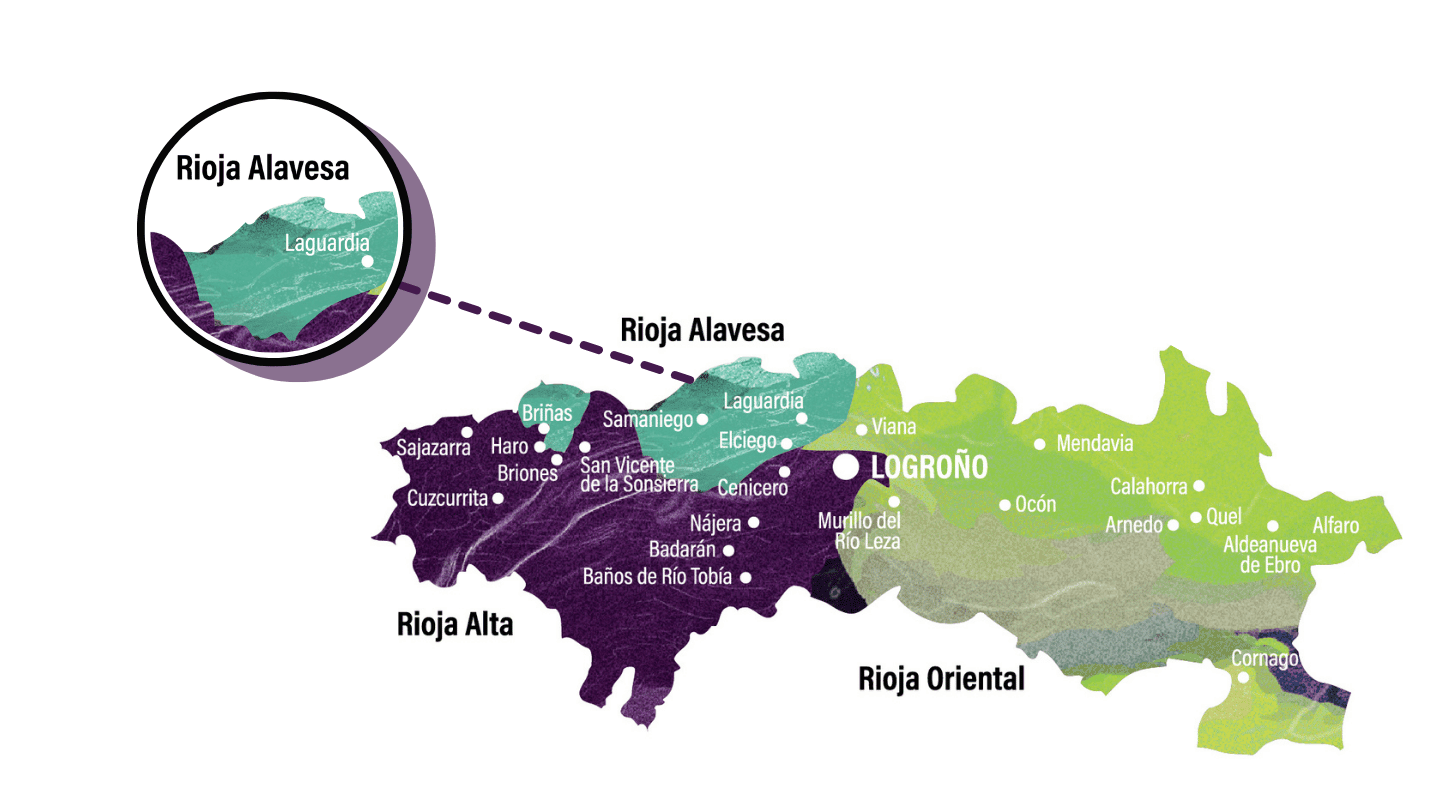
A distinct terroir, unique climate and modern winemaking all shape this Rioja sub-region. Located on the northern bank of the Ebro, Rioja Alavesa is characterized by its white-soiled, terraced vineyards that stretch across the valley and up the nearby Cantabria Escarpment.
In the distance, the looming Sierra Cantabria mountains protect the area from the cold and humid Northern winds off the nearby Atlantic. Even so, Rioja Alavesa enjoys cooler temperatures due to its elevation. The climate, combined with calcareous soil, produces grapes with moderate acidity that are characterful and rich in extract. Many find these wines dense with dark fruits.
Wines are made in all Rioja styles, but the distinctive wines are mainly Tempranillo and reflect the provenance of the grapes (and the terroir).
Interestingly, the region has become known for its modern architecture, with many wineries designed by famous architects. This includes a wavy-roofed winery mimicking the nearby Sierra Cantabria, as well as underground wineries that employ gravity and natural cooling in production. If you have time, you must visit The Marqués de Riscal City of Wine designed by Frank O. Gehry, in the hilltown of El Ciego. Laguardia is the most well-known village in Rioja Alavesa, built on a high hilltop and originally a stronghold protecting the area. There is a warren of limestone wine cellars beneath the village, all connected; tours are available.
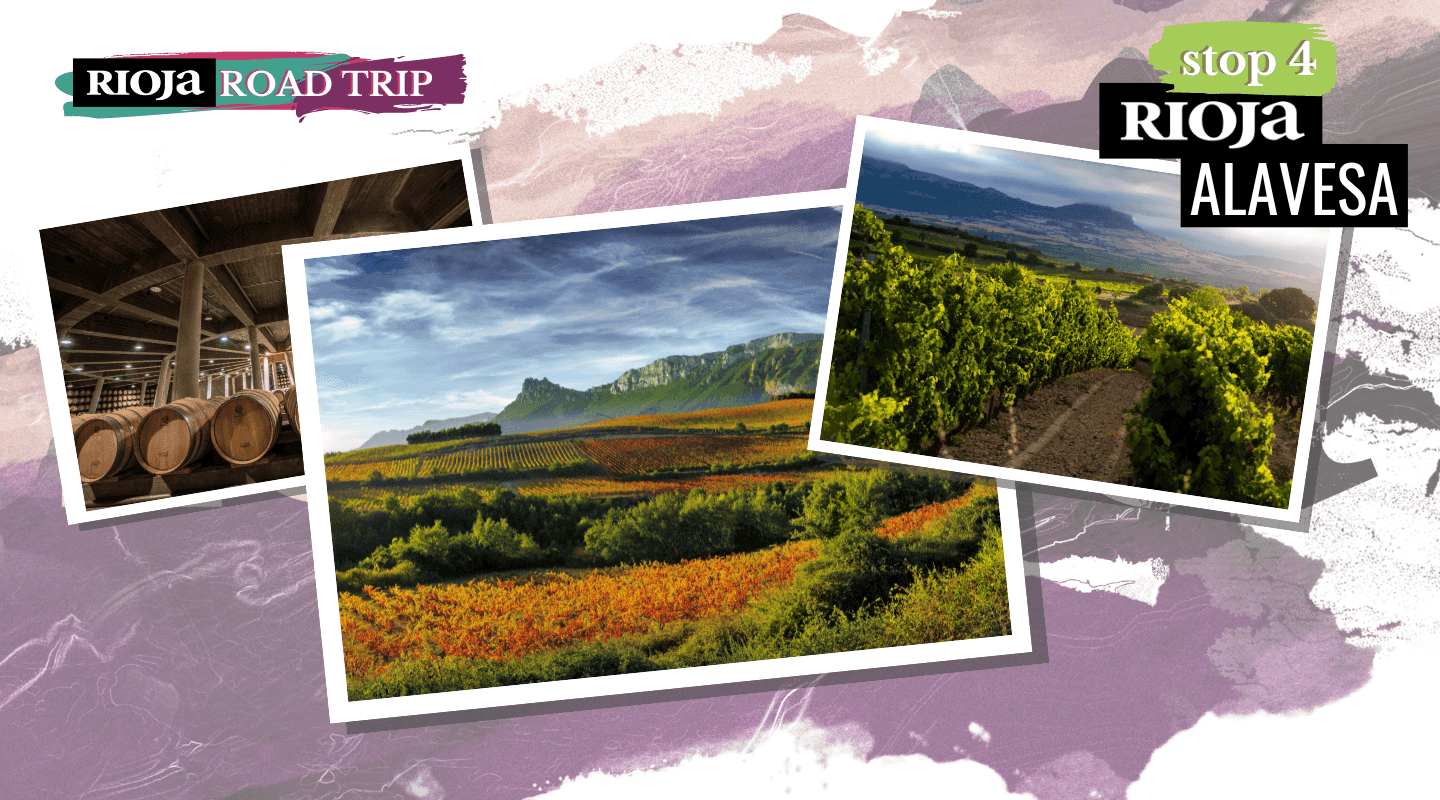
Predominantly Tempranillo, all other varieties grown here except Garnacha, which needs heat.
Rioja Alavesa red wines will be dense, tasting of dark fruits. With a few years on them, notes of soy sauce and menthol (balsamic) abound. White wines that grow here are crisp and aromatic, made from Viura, Sauvignon Blanc and Tempranillo Blanco.

- Dating back to 1500 BC, settlements from the Bronze Age have been found in Rioja Alavesa.
- Historically, carbonic maceration was the most common type of production in Alavesa due to the distance from vineyards to wineries.
- There are two famous centenary bodegas in Rioja Alavesa: Marques de Riscal in El Ciego and Bodegas Faustino in Oyon. Both make wines in the classic style.
- The smallest of the three sub-regions, Rioja Alavesa still represents 20% of Rioja’s wine production.

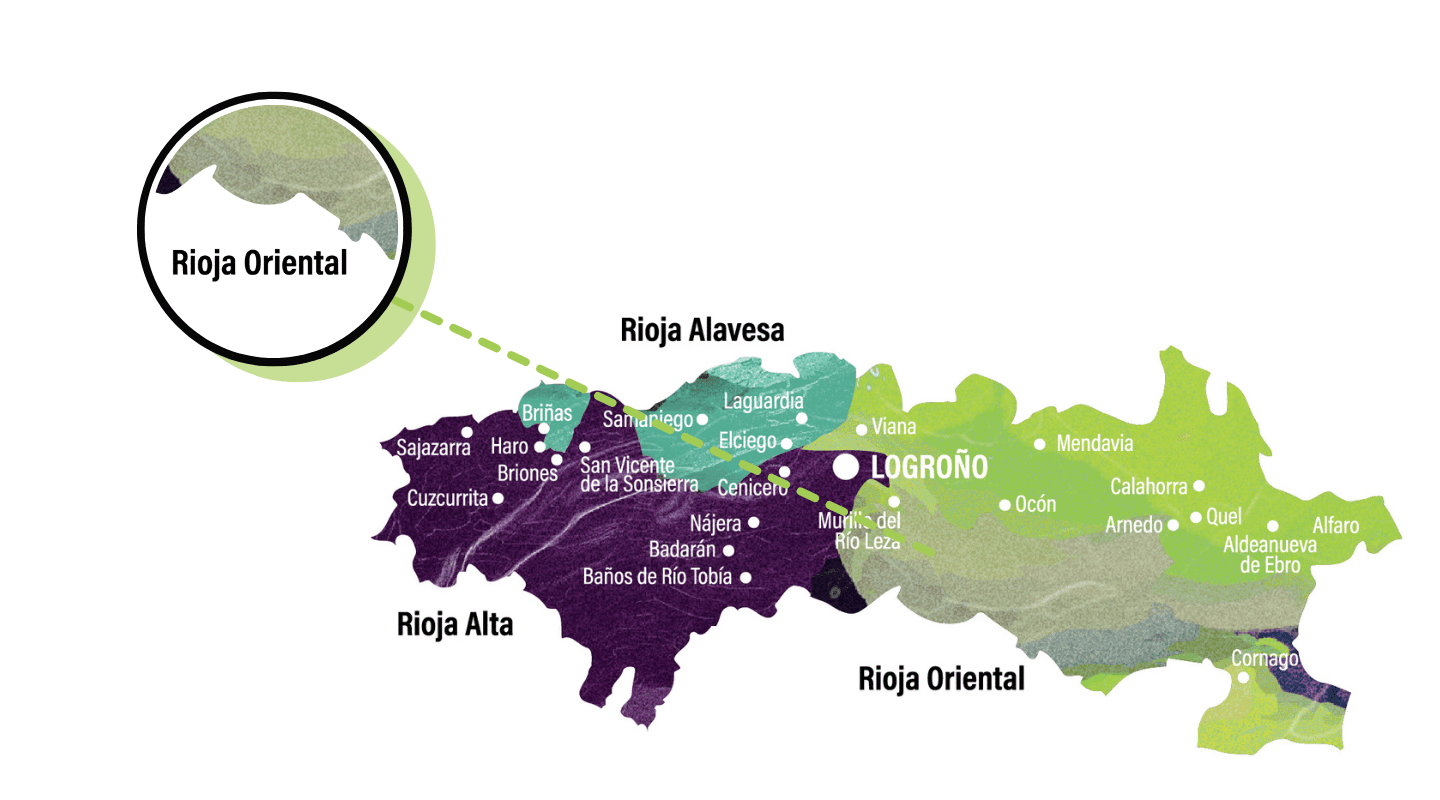
As we move east we enter the warmest, largest and fastest growing sub-region of Rioja. While Rioja Oriental historically focused on viticulture, over the past three decades newer generations of growers have started their own bodegas rather than selling grapes to famous bodega brands in Rioja Alta.
Warm, dry, Mediterranean winds in Rioja Oriental keep pests and diseases at a minimum, allowing for Rioja’s highest concentration of organic vineyards. Soils of this subregion are mainly alluvial and ferrous-clay.
Garnacha flourishes in Rioja Oriental’s warm climate, but the majority of plantings are now Tempranillo. Growers have recently found the greatest success at higher altitudes, on the raised plains above the Ebro and the slopes of the Yerga Mountain to the south.


- Rioja Oriental was known as Rioja Baja until 2017
- Largest (in area) of the sub-regions
- Wine isn’t the only thing grown in Rioja Oriental. Mixed agriculture in the region features peppers, olives (and olive oil), almonds, mushrooms, dairy/cheese and other veggies. Some growers who produced asparagus eventually turned to growing grapes as modern techniques improved outcomes
- White asparagus, Pequillo peppers and artichokes also come from Rioja Oriental
- Because it is warmer here, Rioja harvest begins in this sub-region
Thank you for joining us on our journey through Rioja!
Check out our Rioja Hub Page for more great educational content including free webinars, stats and even sign up to become a Rioja Wine Expert.








